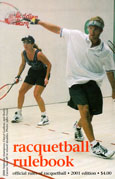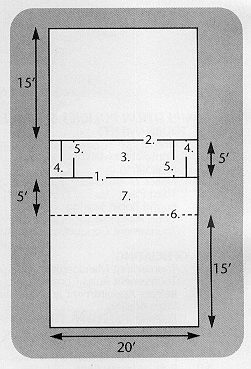|




Order your own hard
copy online!
©
COPYRIGHT NOTICE ! The USRA Official Rules of Racquetball are copyrighted, all
rights reserved, and may not be reproduced, electronically scanned or
downloaded, either in whole or in part, without written permission of the
publisher.
See
"Rulebook
Policies & Fees"
for more information,
or contact: The United
States Racquetball Association |

|
Sections 1.0
& 2.0
w/court diagram
|
1.0 -- THE GAME
1.1 Types of Games
1.2
Description
1.3 Objective
1.4 Points and Outs
1.5
Match, Game, Tiebreaker
RETURN to main
table of contents
Rule 1.1 TYPES
OF GAMES
Racquetball is played by two or four players. When played by
two, it is called singles and when played by four, doubles. A non-tournament
variation of the game that is played by three players is called cut-throat.
Rule 1.2
DESCRIPTION
Racquetball is a competitive game in which a strung racquet
is used to serve and return the ball.
Rule 1.3
OBJECTIVE
The objective is to win each rally by serving or returning
the ball so the opponent is unable to keep the ball in play. A rally is over
when a player (or team in doubles) is unable to hit the ball before it touches
the floor twice, is unable to return the ball in such a manner that it touches
the front wall before it touches the floor, or when a hinder is called.
Rule 1.4
POINTS AND OUTS
Points are scored only by the serving side when it
serves an irretrievable serve (an ace) or wins a rally. Losing the serve is
called a sideout in singles. In doubles, when the first server loses the serve
it is called a handout and when the second server loses the serve it is a
sideout.
Rule 1.5
MATCH, GAME, TIEBREAKER
A match is won by the first side winning two
games. The first two games of a match are played to 15 points. If each side
wins one game, a tiebreaker game is played to 11 points. |
2.0 -- COURTS AND EQUIPMENT
2.1 Court Specifications
2.2 Ball
Specifications
2.3 Ball Selection
2.4 Racquet Specifications
2.5
Apparel
RETURN to main table of contents
Rule 2.1 COURT
SPECIFICATIONS
The specifications for the standard four-wall
racquetball court follow. (See also: construction
specifications).
 (a) Dimensions. The
dimensions shall be 20 feet wide, 40 feet long and 20 feet high, with a back
wall at least 12 feet high. All surfaces shall be in play, with the exception
of any gallery opening, surfaces designated as out-of-play for a valid reason
(such as being of a very different material or not in alignment with the
backwall), and designated court hinders. (a) Dimensions. The
dimensions shall be 20 feet wide, 40 feet long and 20 feet high, with a back
wall at least 12 feet high. All surfaces shall be in play, with the exception
of any gallery opening, surfaces designated as out-of-play for a valid reason
(such as being of a very different material or not in alignment with the
backwall), and designated court hinders. - (b) Markings. Racquetball courts
shall be marked with lines 1 1/2 inches wide as follows:
- 1. Short Line. The back edge
of the short line is midway between, and is parallel with, the front and back
walls.
- 2. Service Line. The front
edge of the service line is parallel with, and five feet in front of, the back
edge of the short line.
- 3. Service Zone. The service
zone is the 5' x 20' area bounded by the bottom edges of the side walls and by
the outer edges of the short line and the service line.
- 4. Service Boxes. The
service boxes, used in doubles play, are located at each end of the service
zone and are designated by lines parallel with the side walls [see
4.2(b)]. The edge of the line nearest to the center
of the court shall be 18 inches from the nearest side wall.
- 5. Drive Serve Lines. The
drive serve lines, which form the drive serve zone, are parallel with the side
wall and are within the service zone. The edge of the line nearest to the
center of the court shall be three feet from the nearest side wall.
- 6. Receiving Line. The
receiving line is a broken line parallel to the short line. The back edge of
the receiving line is five feet from the back edge of the short line. The
receiving line begins with a line 21 inches long that extends from each side
wall. These lines are connected by an alternate series of six-inch spaces and
six-inch lines. This will result in a line composed of 17 six-inch spaces, 16
six-inch lines, and two 21-inch lines.
- 7. Safety Zone. The safety
zone is the 5' x 20' area bounded by the bottom edges of the side walls and by
the back edges of the short line and the receiving line. The zone is observed
only during the serve. See Rules 3.10(i) and 3.11(a).
Rule 2.2 BALL
SPECIFICATIONS
- (a) The standard racquetball
shall be 2 1/4 inches in diameter; weigh approximately 1.4 ounces; have a
hardness of 55-60 inches durometer; and bounce 68-72 inches from a 100-inch
drop at a temperature of 70-74 degrees Fahrenheit.
- (b) Only a ball having the
endorsement or approval of the USRA may be used in a USRA sanctioned
tournament.
Rule 2.3 BALL
SELECTION
- (a) A ball shall be selected by
the referee for use in each match. During the match the referee may, based on
personal discretion or at the request of a player or team, replace the ball.
Balls that are not round or which bounce erratically shall not be used.
- (b) If possible, the referee and
players should agree to an alternate ball, so that in the event of breakage,
the second ball can be put into play immediately.
Rule 2.4
RACQUET SPECIFICATIONS
- (a) The racquet, including
bumper guard and all solid parts of the handle, may not exceed 22 inches in
length.
- (b) The racquet frame may be any
material judged to be safe.
- (c) The racquet frame must
include a cord that must be securely attached to the player's wrist.
- (d) The string of the racquet
must be gut, monofilament, nylon, graphite, plastic, metal, or a combination
thereof, and must not mark or deface the ball.
- (e) Using
an illegal racquet will result in forfeiture of the game in progress or, if
discovered between games, forfeiture of the preceding game.
Rule 2.5
APPAREL
- (a) All
players must wear lensed eyewear that has been warranted by its manufacturer or
distributor as 1.) designed for use in racquetball and 2.) meeting or exceeding
either the full ASTM F803 standard or Canadian (CSA) impact standard. This
rule applies to all persons, including those who wear corrective lenses.
The eyewear must be unaltered and worn as designed at all times. A player who
fails to wear proper eyewear will be assessed a technical foul and a timeout to
obtain proper eyewear. A second infraction in the same match will result in
immediate forfeiture of the match. [See Rule 3.17(a)9]
[view injury report]
- Certifications &
Compliance. The USRA maintains a reference list of eyewear so warranted by
their manufacturers, and provides that list to each sanctioned event (an
eyewear list dated more than 90 days prior to the first day of the tournament
will be deemed invalid for the purpose of determining compliance with this
eyewear rule). In addition, the list is available online at the USRA.org
website (indexed under
"eyeguards"), and individual copies may be requested by
calling the USRA National Office at 719/635-5396.
- To be used in sanctioned
competition, protective eyewear must:
— bear a permanent, physical
stamp of the appropriate "ASTM-F803" citation on the frame itself, OR
— appear on the ASTM reference listing, OR
— bear the
"Protective Eyewear Certification Council" [PECC] seal of approval for the ASTM
standard, OR
— be certified in writing by the maker that it complies
with the required ASTM standard (in this instance, the player must be able to
provide written, adequate proof - on demand - at any sanctioned event, before
such eyewear may be used).
- (b) Clothing and Shoes. The
clothing may be of any color; however, a player may be required to change wet,
extremely loose fitting, or otherwise distracting garments. Insignias and
writing on the clothing must be considered to be in good taste by the
tournament director. Shoes must have soles which do not mark or damage the
floor.
- (c)
Equipment Requirements During Warm-up. Proper eyeguards [See Rule
2.5(a)] must be worn and wrist cords must be used during
any on-court warm-up period. The referee should give a technical warning to any
person who fails to comply and assess a technical foul if that player continues
to not comply after receiving such a warning.
|
Top of Document |
USRA Homepage

© All website contents are copyright USRA -- All
Rights Reserved
|
|





